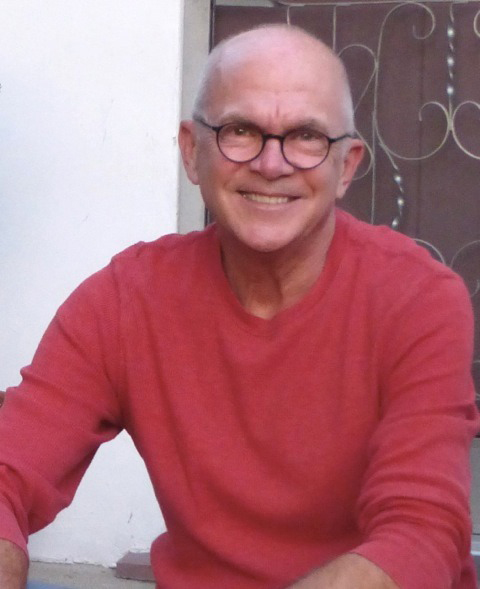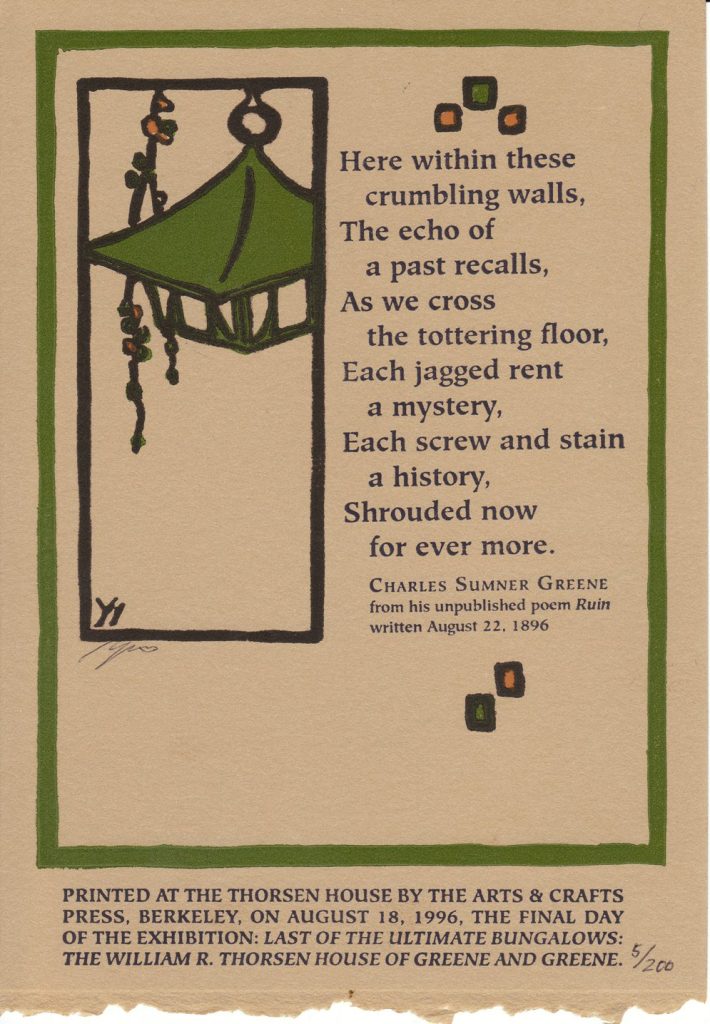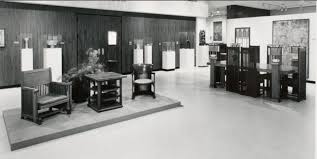Lee Sanders and Docent friends on a 1998 arts and architecture tour of Chicago
OUR STORY THROUGH THEIR EYES: LEE SANDERS Making It a Bookstore With a Capital “B”
By Bobbi Mapstone, Gamble House History Committee

Lee Sanders was destined for a life in art and architecture. His parents, interior designers and antique collectors, greatly influenced his love of historic buildings, antiques, and the decorative arts. His uncle, a devotee of Frank Lloyd Wright and Midcentury Modernism, instilled an appreciation for the avant-garde. Add to the mix youthful visits to historic homes throughout the country and you can see why The Gamble House was a perfect fit.
It was 1988 and Lee was hard at work in his 15th year at the Norton Simon Museum’s bookstore, a high-end shop in Pasadena that carried a wide assortment of books and gifts relating to the world of art. He wasn’t actively looking for a change, but then-Director Randell Makinson came into his life at that moment, enticing him with the brand new position of…Gamble House Bookstore Manager.
Momentum was on our side. Lee had visited The House and through his work met Gamble House Docents including Rea Taylor. Furthermore, Lee’s favorite aunt, Ruth, a docent for 25 years at the Seattle Art Museum, was very encouraging. It was time for a change, new challenges, fresh experiences, and Randell was very persuasive.
BUILDING THE BOOKSTORE—TOGETHER
Shortly after the House opened to the public in 1966, a few books were available for visitors to purchase. By March 1988, when Lee was hired, the Bookstore had grown under the guidance of longtime Gamble House Docents Virginia Martens and Doris Gertmenian and offered a selection of books and magazines relating to the work of Charles and Henry Greene.
From its origins in the House, the Gamble House Bookstore had been moved to the garage where it shared space with the Greene & Greene Library (later renamed the Greene & Greene Archives). A partition wall that didn’t compromise the structure separated the two groups with the Bookstore on the right.
Some Greene & Greene furniture that had been gifted to the House was stored in the garage and Lee recalled that his first display table came from the Robinson House in Pasadena. “Even though it was covered with padding it made me nervous to use and be responsible for the care of this historic piece,” he said. His office was at the back of the garage on the right with the door opening to the Rose Garden. It was, he said, a privilege to occupy such a space.
Lee had never worked with docents at the Norton Simon, but thanks to his family he appreciated the value of volunteering. With Virginia as the Docent liaison and her vast knowledge of the store’s operational history, he soon grew to enjoy what he refers to as “The Gamble House way.” Anyone who has taken docent training or worked at the House probably understands what that means (Lee trained with the Class of 1989). Before long, the Library moved to the Huntington, the Robinson table had another home there, and the room divider was gone.
GROWING BY LEAPS AND VOLUMES
When Lee arrived, the Arts & Crafts craze was relatively young and the Bookstore primarily spotlighted The Gamble House and Greene & Greene. When he left 10 years later, the focus had expanded to include Arts & Crafts in America—with books on Hearst Castle, Bernard Maybeck, Gustav Stickley, the Roycroft community, Ernest Batchelder, and more; and Arts & Crafts internationally—with tomes on Charles Rennie Mackintosh, William Morris, and others. He also shared his passion for decorative arts with books on Art Nouveau, Art Deco, and other movements that caught the public’s interest.
Inventory was key. Under the earlier setup, when an appropriate book was newly published, the entire run was acquired. One of Lee’s first projects was to return large quantities to the publishers. He led Virginia and her talented and dedicated crew of Bookstore Docents as they transferred to a more efficient management system.
Randell, encouraging and appreciative, sent Lee to Chicago to see the Frank Lloyd Wright Home and Studio as well as attend book shows. The contacts he made helped expand his vision and the scope of the Bookstore.
DOCENTS: “THE BACKBONE OF THE BOOKSTORE”

Lee is emphatic that “Docents were the backbone of the Bookstore from the outset and it couldn’t have continued without their support.” They were the sales staff, manually priced every item prior to barcodes, kept it operating, and everyone made contributions based on their own history, experiences, and interests. “Most of all, they made every visitor feel welcome.”
Several regulars made particularly significant contributions (“There were too many to name them all, so please forgive me,” Lee said). He met Betty Brown on his first day and she was there every Friday thereafter; Barbara Dahn was responsible for book reports to the newsletter; and Docent Council Presidents were very well represented: Nancy Marino, Bill Farmer, Phyllis Manley, and of course Virginia, who gave monthly reports of Bookstore activities at Docent meetings. “Jane Bell was the fortunate one who answered calls from people interested in ‘gambling’ and the Bookstore would be filled with laughter.”
Patty Heather was a regular and Ann Chaves, a collector and Arts & Crafts artisan, contributed immensely and brought her Roycroft connections. Kathy LaShure started as a Docent and then became a member of the staff; she was indispensable in technical matters and catalogs.
Most times the Bookstore had a committee of 30 Docents involved. Together with the Ticket Sales Committee they worked harmoniously in the store, though sometimes constructive guidance was required. Lee recalled feeling just a bit uncomfortable when giving pep talks to the Docents, all twice his age, on methods and procedures they needed to follow.
Lee’s gratitude still runs deep. “So many people gave so much and it was their energy, support, hard work, professionalism, humor, and endless commitment that made it all possible. The Bookstore was a wonderful place to work.”
TAKING THE STORE ON THE ROAD: THORSEN AND BLACKER HOUSES
One of the most wonderful aspects of his time at the House, Lee said, was the William R. Thorsen House “Last of the Ultimate Bungalows” exhibition in Berkeley in summer 1996. It was exciting for the entire staff who were happy to see Gamble House Director Ted Bosley cement his connection to the two houses by reuniting the Thorsen House with its furniture that had been gifted to The Gamble House.
The Thorsen House, home of California Sigma Phi where Ted lived as a UC-Berkeley student, was turned into a “quick house museum” open to the public for nine amazing, crowd-filled weeks. The students moved out at the end of the semester and The Gamble House crew with Ted and Lee at the helm arrived to transform it into a museum and bookstore—a seemingly impossible task with many hurdles.
The House was gorgeous but needed some work, and an uninspiring garage was transformed into a great bookstore with a huge inventory and products by Arts & Crafts artisans. Diane Ayres created packaged needlepoint kits that sold faster than she could produce them while Bruce Smith and Yoshiko Yamamoto, who had recently started their own Arts & Crafts printing company, brought a small printing press and created impromptu keepsakes with a poem by Charles Greene.
The Gamble House staff (Ted, Lee, Bobbi Mapstone, Kathy LaShure) were there on shifts throughout the whole run and teams of Docents and Friends of The Gamble House commuted in waves between Pasadena and Berkeley to keep it running, while Lee maintained the quality inventory by reordering at an unusual pace. It was very exciting and as Lee recalled, sleeping in a Greene & Greene house was a huge perk. It wasn’t, however, to be the biggest off-site bookstore…
That was the Robert R. Blacker House in Pasadena, home to three-day tours over three weekends in October 1998. It didn’t seem possible to outdo the Thorsen House experience but this time instead of a garage the bookstore was located in the elegant Billiard Room. Setting up and running the store, with the Gamble House shop open as well, was a rollercoaster of people and activities and, as always in the true Gamble House spirit, everyone pitched in.
Other offsite Bookstore activities that brought the word to Arts & Crafts aficionados took place at Bungalow Heaven and Craftsman Weekend in Pasadena, Greene & Greene house tours, and across the country at the Grove Park Inn Arts & Crafts Conference in North Carolina.
NOTABLES IN THE STACKS
One never knew who would walk through the Bookstore’s door. The Gamble House Lecture Series brought in renowned speakers, the House attracted visitors from around the world, and there were book signings and Greene & Greene-related events.
Lee recalled one quiet day when Cornelia Hopfield, a regular Bookstore Docent, was helping a young man interested in a big-ticket item. Lee, a bit dubious, was hovering until she elbowed him and quietly said, “He’s OK.” The young man in question was Brad Pitt, who became a very good customer.
During Lee’s 10-year tenure, interest in the Arts & Crafts Movement kept expanding and the Bookstore followed suit, offering an ever-widening variety of books, magazines, and craft items. It became the “go to” place for anyone interested in the movement and, as Lee often says, it was through the Docents that he gained insight into running the Bookstore “the Gamble House way.” It was work, it was growth, it was fun.
About Lee
Lee was the first Manager of the Gamble House Bookstore, serving from March 1988 to December 1998 (Docent Council Class of 1989). He shares its success with dozens of Docents, who truly were “the backbone of the Bookstore.”
He left The Gamble House to move to Sydney, Australia, where he fostered his book business online and at book shows. Lee retired recently, lives in Tasmania, Australia, and is in search of the next great volunteer opportunity.



Leave a Reply